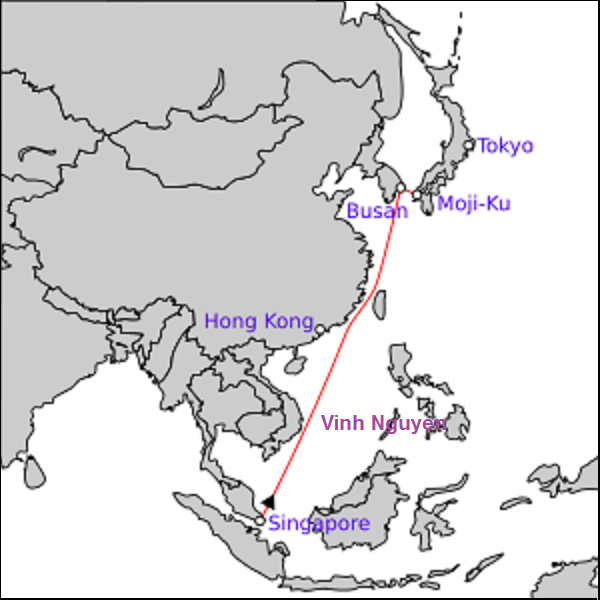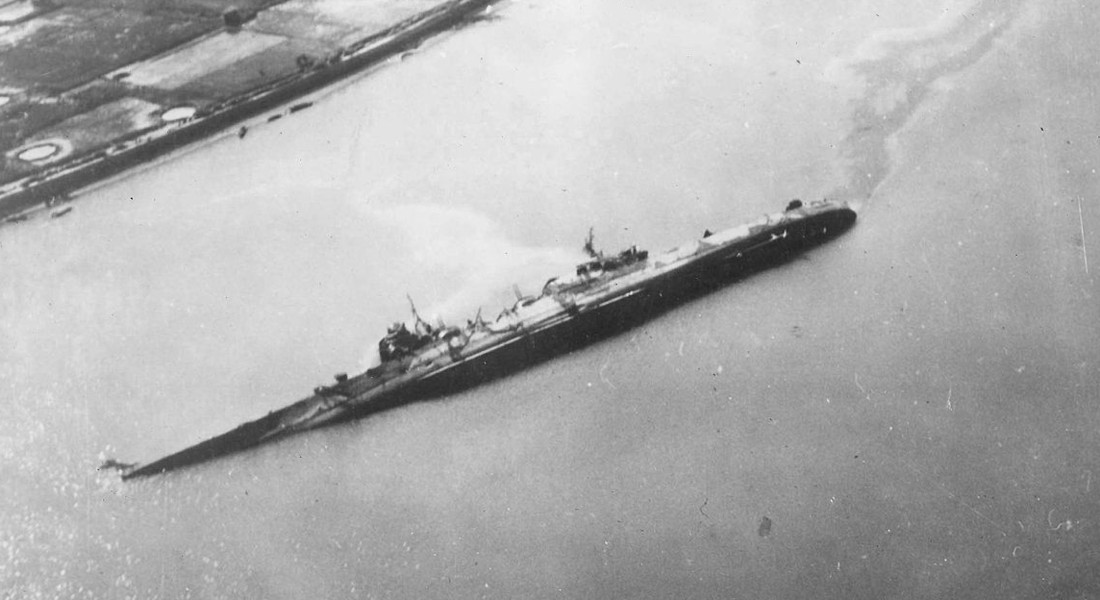Setting: South China Sea, off the coast of Vietnam. (Allies acting on radio intercepts.)
The Japanese were running Operation Kita, where the battleships Hyuga and Ise, cruiser Oyodo and three destroyers were to transit from Singapore to Japan carrying a range of fuels, scarce metals and other resources badly needed by the Japanese Homeland Industries.


A range of Allied submarines were laid in wait for the Japanese ships with a back-up force of British ships waiting in the South China Sea to intercept the remaining ships after the submarines had had their way with them.
With Admiral Vian in command on board the Battleship, Duke Of York (12x15"), accompanied by the Warrior and Minotaur, with the light cruisers Jamaica and New Zealand (9x6"), and six brand new U and V class destroyers (6x4.7"). All ships could make 30 knots or more. This Squadron was considered more than enough to take care of the Japanese force.
The submarine Tantalus reported the Japanese force leaving Singapore and tried to get into position for an attack. However the Japanese ships were moving at 22 knots and the Tantalus fell behind. This same event happened to several other US and UK submarines that tried to intercept the Japanese force only to find themselves behind and falling further behind as the Japanese sped off into the night. Inclement weather also made the submarines task that much harder. It also transpired after the event that the Japanese were using radar detectors that allowed them to plot where the subs were and alter course to make their interceptions almost impossible.
Once it looked like the submarines were not going to be able to make the interception of the Japanese force, Admiral Vian ordered his ships into there search positions and headed for the calculated interception point of Camranh Bay on the coast of Vietnam. Even Admiral Vian had slightly miscalculated but was kept up to date by position updates from those submarines still in contact with the Japanese ships. A course correction was made that would intercept the Japanese force north of Camranh Bay and speed was increased to 25 knots. Two hours later the report of 'Contact' is received from Jamaica at the point position of the line. More reports followed with the layout of the Japanese line. Firing orders were given. The idea was to overwhelm the cruiser and destroyers first to put their 24" torpedoes out of action. Those torpedoes were the Joker in the pack that could turn the battle against the British if the Japanese were able to launch. Admiral Vian ordered "Execute" and the slaughter began. Duke of Yorks gunnery radar had been plotting the Oyodos position for the last 20 minutes and had the range down to the yard. The eerie view of the guns firing with flashless powder went up and down the line. Four of Duke of Yorks first four shells hit the Oyodo, followed by huge gouts of flame as the deck cargo of petroleum products in cans exploded. These explosions turned the immediate area around the Japanese ships as bright as day. Another salvo from the big ships and the Japanese ships were aflame from bow to stern. Admiral Vian ordered "Change target to the Battleships".
Admiral Vians mistake was to cost the British dearly. One destroyer, though damaged enough to later sink, had managed to swing one set of torpedoes out and virtually fire blind at the indistinct British line. One more salvo on the light ships could have prevented the Minotaur from receiving three torpedo hits. The first two hits were on the armoured belt and while causing large damage, the ship might have survived. It was the third hit at the end of the armour aft that was the fatal one. In designing their Torpedo Defense Systems, the British had only taken into account the standard torpedos with 250-300kg warheads. This was no match for the 500kg Long Lance torpedoes of the Japanese. That hit aft exploded into the aft magazine and like many a British battlecruiser before it, the Minotaur blew up. The ship split in half, the aft section sinking almost immediately while the forward section stayed afloat long enough for HMNZS New Zealand to go along side and take aboard the survivors.
Meanwhile The Duke of York was rapidly turning the Hyuga into a blazing colander, its 15" guns taking deadly toll. The Warrior and Jamaica were doing the same to the Ise. The Jamaica's 6" guns exploding amongst the deck cargo and the cargo stored in the huge hangar aft. With such bright targets to fire at almost every shot was a hit. The whole battle from the opening salvo to the last took only 45 minutes. Only the loss of the Minotaur spoiled what should have been a text book victory. It was still a resounding victory 6 Japanese ships sunk for only one British loss was pretty decisive.
IJN Oyodo run aground after the Battle of Vin Nguyen.

Admiral Vian withdrew back out to sea to meet the rest of the British Pacific Fleet. Air cover arriving over the ships at dawn in case Japanese aircraft found the withdrawing ships before they could rejoin the safety of the Fleet.
Very few Japanese were rescued, the fires from the ships cargo set fire to the fuel oil from the ships bunkers which incinerated those crew that managed to get overboard into the sea. Those that did survive had managed to launch boats and rafts to get them away from the ships.
This was the last attempt by the Japanese to force the submarine blockade of the Home Islands.